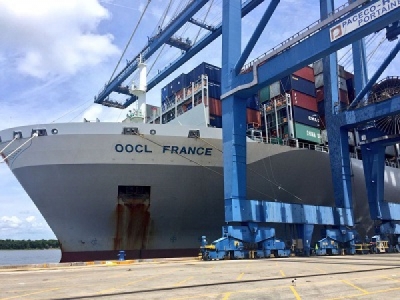
Posted on November 2, 2017
By David Wren, The Post and Courier
A key part of the plan to dredge Charleston Harbor to 52 feet received the go-ahead Monday with the announcement of the most expensive contract in the history of the Army Corps of Engineers — a $213 million deal to help make the waterway the deepest on the East Coast and more accessible to supersized cargo ships visiting the Port of Charleston.
“We look forward to seeing dredges in our harbor in the next few months,” said Jim Newsome, president and CEO of the State Ports Authority. “The investment in harbor deepening … and multiple other projects to improve our existing and inland infrastructure will pay dividends to South Carolina’s economy for many years to come.”
The contract for the second phase of the project was awarded to Great Lakes Dredge and Dock of Oak Brook, Ill. The second phase includes deepening the 20-mile inner harbor to 52 feet from 45 feet, from the entrance channel to the Wando Welch and North Charleston container terminals, including the Hugh Leatherman Terminal under construction on the former Navy base.
“This is a complicated and difficult project, requiring a wide variety of equipment and extensive environmental care and oversight,” said David Simonelli, president of Great Lakes. “We’re looking forward to getting started.”
Great Lakes also earned the previously awarded $47.2 million first-phase contract to dredge the harbor’s entrance channel to a 54-foot depth.
Two more phases will complete the estimated $529 million project.
The first-phase dredging will begin this fall and the entire project is scheduled to wrap up by 2020, when the Leatherman Terminal opens.
Lt. Col. Jeffrey Palazzini, the local Army Corps commander, said the Charleston Harbor initiative “has served as a role model for deep-draft navigation projects around the world,” adding that some of the dredge material will be used to create nine artificial reefs plus a berm around the offshore dredge material disposal site.
“The relationship between the port and the Army Corps is really unparalleled,” Palazzini said. “We’ve learned a lot from each other through the years and we’ve worked together to ensure this critical project gets done.”
Gov. Henry McMaster said the deepening project will play an important role in South Carolina’s economic growth and ability to lure manufacturers and other businesses.
“The impact of this port on our state is nothing short of fantastic,” McMaster said. “This is one of the best success stories there is.”
Newsome said the project would not have been possible if South Carolina legislators hadn’t previously set aside the state’s $300 million share of the project. The rest of the funding will come from the federal government. The Army Corps will be able to use the state’s money to keep the project going without delays while federal funds are appropriated in coming years.
The General Assembly’s decision to advance funding for the project “has been critically important through every milestone and helped Charleston move faster than any other civil works project to date,” Newsome said, adding the SPA “will continue to work diligently to secure the remaining federal share of the project.”
The project began in 2011 when a Corps of Engineers study determined there is federal interest in deepening Charleston Harbor and cited the project as a best value for public dollars. It has progressed more quickly than any federal deepening project to date.
Charleston Harbor is currently 45 feet deep, and large, heavy container ships must wait for rising tides before they can enter and leave the port. A 52-foot depth will let those vessels come and go at any time. That would give Charleston an advantage over other East Coast ports with shallower channels while allowing ships to haul heavier loads.
The dredging is part of the SPA’s plan to improve infrastructure to accommodate large container ships traveling through the expanded Panama Canal to the East Coast. That plan also includes the Leatherman Terminal, an intermodal rail yard in Dillon County, new cranes and other equipment and improvements to an existing wharf.
All told, the SPA plans to spend more than $1.5 billion in coming years to lure the so-called neo-Panamax vessels carrying about 14,000 or more shipping containers at a time.
Source: The Post and Courier





